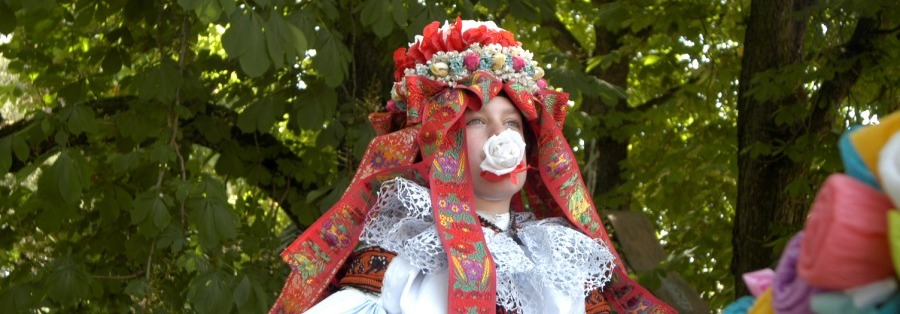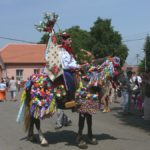UNESCO list: 2011, National list: 2009.
The Ride of the Kings is – as an annual custom – a ceremonious horseback procession of boys, or men in some places, who have a king – a teenage boy dressed in women´s festive folk costume – among them. The King is accompanied by his guards (aides) – riders of the same age as the rest of the cavalcade is, however, the aides are dressed in the same women´s folk costumes, as the King is, and they hold unsheathed sabres in their hands to protect the King. The cavalcade on decorated horses travels around the village, it stops at houses and the riders chant short rhymes addressing the domestic people and outsiders. The rhymes can be complimentary, humorous or even pejorative and the riders comment positive or negative character traits of a person concerned, or his or her physical appearance. The person at whom a rider from the cavalcade calls out is expected to donate some money to the rider.
Reprezentativní seznam - Nominační dokumentace "Jízdy králů" verze CZ ENG version
Národní seznam - Nominační dokumentace "Jízdy králů"

The not exactly clear origin of the ride of the kings allowed the erudite researchers to develop theses about the original form of the ritual, and its functions. The most distinctive element in the ritual can be related to initiatory rites as well as rites having a protective function with the aim to ensure successful farming through magic practices and means. The explanations that speak about the remnants of pagan rites and rituals of pre-Christian Slavs, which changed over centuries, seem to be at the closest to the truth. The custom of the ride of the kings at Pentecost (Whitsuntide) was widespread and carried out, in different forms, not only in Moravia, but also in Slovakia, Silesia, Bohemia, Poland and Ukraine.
Historical reminiscences regarding the ride of the kings are emblazoned with interesting, impressive and authentic-looking legends and tales. One of them considers the custom to be a folk parallel to medieval knight´s games and to be based on festive parades held during knight tournaments. Other explanations are based on an assumption that the custom takes place to commemorate the pursuit of the king. The most frequent assumption proceeds on a historic event from 1469 and a story about the chase of King Matthias Corvinus. King Matthias´s troops are said not only to have been repelled – after an unsuccessful siege of the town of Uherské Hradiště – with the invited aid of Jiřík from Poděbrady, but even to have suffered a defeat near the village of Bílovice. King Matthias had to flee from the battlefield. To preclude incarceration and to save his life, he had to escape to the nearby town of Uherský Brod. The victorious troops pursued him to this town. He is said to have been led through a secret corridor, in the guise of a girl, out of the town, and to have escaped to Hungary. The ride of the kings is supposed to have been commenced in commemoration of this event. And maybe to make this legend more credible, a supplement is added saying that the king from the current ride is also dressed in girl´s folk costume and he holds a rose in his mouth to avoid his male voice betraying him, and he is accompanied by a cavalcade to guard him.
Until the mid-1930s, the ride of the kings took place regularly in many villages in south-eastern Moravia. This custom was that living that the people considered it to be a natural part of the Whitsuntide, without current opulence. These days, the ride of the kings is regularly organized in several locations only. In Europe, there is no other corresponding parallel to the ride of the king as a Pentecost ritual at the turn of spring and summer, and for this reason we can speak about exceptionality and importance of this custom as a unique witness to a living cultural tradition in the Czech Republic.



